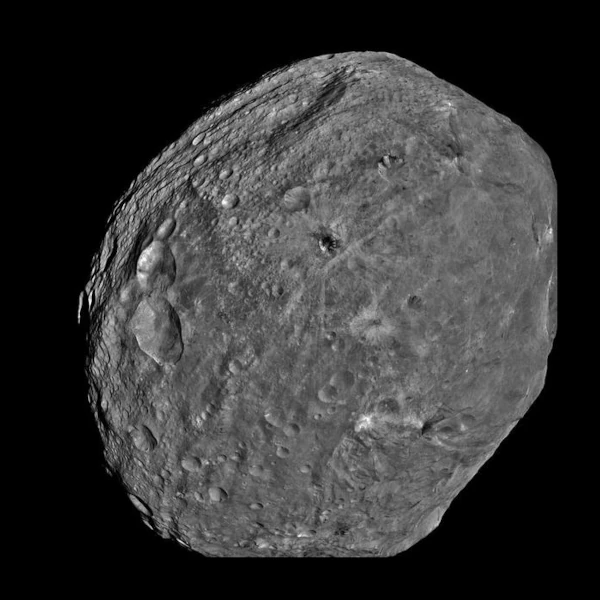
With an average diameter of 525 km, (4) Vesta is the second-largest body in the main asteroid belt. Discovered on March 29, 1807 by Heinrich Wilhelm Olbers (1758-1840), it alone accounts for nearly 9% of the total mass of the belt. Its surface reflects up to 43% of sunlight (albedo of 0.43), making it visible to the naked eye under optimal conditions.
Observations by the Dawn probe (2011-2012) revealed:
The Rheasilvia crater (500 km in diameter) at the south pole is evidence of a cataclysmic impact that ejected 1% of Vesta's total volume. The HED meteorites found on Earth (such as the Millbillillie meteorite in Australia) confirm this origin.
| Parameter | Vesta | Ceres | Pallas |
|---|---|---|---|
| Mean diameter (km) | 525 | 940 | 512 |
| Mass (×1020 kg) | 2.59 | 9.39 | 2.14 |
| Density (g/cm3) | 3.42 | 2.16 | 2.89 |
| Rotation period | 5.34 h | 9.07 h | 7.81 h |
Sources: Dawn Mission (NASA) and JPL Small-Body Database.
The study of Vesta provides valuable clues about planetary formation. Its internal differentiation (separation of core, mantle, and crust) suggests it is an aborted protoplanet, whose growth was interrupted by Jupiter's gravitational influence. Spectral analyses reveal a composition similar to eucrite meteorites, confirming its role as a "fossil" from the first few million years of the solar system.
Vesta is one of the few asteroids sometimes visible to the naked eye, but its observation requires optimal conditions. Its maximum brightness (magnitude ≈ 6.1) occurs during oppositions, when it is closest to Earth and fully illuminated.
To maximize your chances, favor moonless nights (around the new moon) and an observation site far from urban lights. Vesta will appear as a fixed point of light (unlike stars, which twinkle), located near the constellation Orion. Its identification is facilitated by its slightly yellowish color and its perceptible movement over 2-3 nights relative to background stars.
Note: Even under optimal conditions, Vesta remains a borderline object for the human eye. Using binoculars (even 7×50) clearly reveals its brightness and allows tracking its orbital motion. Experienced observers note that its visibility is best in the second half of the night, when Vesta culminates more than 50° above the southern horizon (from the northern hemisphere).
| Opposition Date | Magnitude | Distance from Earth (AU) | Constellation | Naked-Eye Visibility | Optimal Period (±1 week) |
|---|---|---|---|---|---|
| May 2, 2025 | 5.7 | 1.57 | Libra | Yes (dark sky) | April 20 - May 10, 2025 |
| December 15, 2025 | 6.1 | 1.54 | Orion | Yes (dark sky) | December 5-25, 2025 |
| October 13, 2026 | 6.2 | 1.60 | Pisces | Difficult (gibbous moon) | October 3-23, 2026 |
| January 31, 2028 | 6.0 | 1.52 | Taurus | Excellent | January 21-31, 2028 |
| July 9, 2029 | 5.8 | 1.55 | Virgo | Good | June 29 - July 19, 2029 |
| November 24, 2030 | 6.6 | 1.59 | Taurus | Not visible to naked eye | November 14-30, 2030 |
| March 20, 2032 | 6.5 | 1.60 | Virgo | Not visible to naked eye | March 10-26, 2032 |
| September 8, 2033 | 6.6 | 1.58 | Pisces | Not visible to naked eye | August 29 - September 14, 2033 |
Sources: Minor Planet Center (IAU) and JPL Small-Body Database (NASA).
Magnitudes are calculated for an observer located at 45° north latitude.